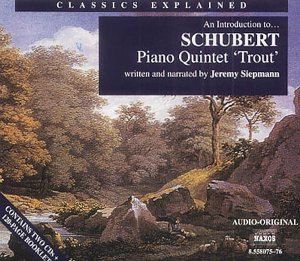As Jeremy Siepmann proclaims, "Of all the
great composers, Schubert was the most convivial and the most
careless … inspired melody, coloured by hardly less inspired harmony,
flowed from his pen as naturally as rivers flow into the sea."
Yet this in-depth study of Schubert’s "Trout" Piano
Quintet, surely proves the lie to the hoary old legend about Schubert
rattling off compositions (admittedly smaller-scale compositions,
especially songs, although the principle still holds true) on
the backs of menus in coffee houses. Siepmann, in a 126-example,
two-hour+ detailed analysis, shows just how much skill and sophistication
went into what he describes as one of the "ultimate feel-good
pieces"; a work that "as an anti-depressant … has few
rivals".
The booklet commences with an introductory section
sketching in the composer and the work. It covers the historical
background including a description of Vienna in Schubert’s time,
a biographical sketch of Schubert and ‘The Place and Importance
of the "Trout" Quintet in Schubert’s output.’ The Analysis
section has the spoken text of the analysis (very useful for detailed
leisurely study), plus a structural overview and a detailed 13-page
section on interpretation of the Quintet. If all this was not
enough, this generous publication concludes with nearly forty
pages devoted to the ‘Art of the Listener’ comprising: ‘Ways of
Listening’, ‘What Music Is’, ‘What Music Is Not: Music and Snobbery’,
‘A Brief Guide to the Composer’s Tools’ , ‘The Basic Forms of
Music’ and a ‘Glossary’.
Siepmann’s absorbing in-depth narration is delivered
with humour and the lightest of touches, including, seamlessly,
easy-to-grasp and vividly graphic explanations of technical terms.
The performance of the Quintet is very good.
Ian Lace
see also review by Robert
Hugill and Gary
Higginson
